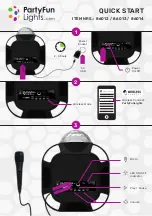
PREMIER M PLUS USER MANUAL & MAINTENANCE GUIDE
Approved Document No: GLT.MAN-112
PAGE 9
Issue: 2.3 Author: NRPJ Date: 25/5/2017
6. THE FAULT CONDITION
6.1 DIFFERENT TYPES OF FAULT
The fire alarm monitors itself, and any equipment connected to it, for any faults that can occur. If a fault occurs, the Panel responds
by activating its Internal buzzer and lighting the General Fault light and any other Fault light(s) relevant to the particular fault. The
Panel’s Fault relay will also activate. Typical faults are described below: -
Common Fault
The Common Fault LED is a common indicator that lights when
there is a Fault on any part of the Fire Alarm Systems.
It is usually lit in tandem with at least one other fault light which
conveys more precise information on the type of Fault detected.
If this light is lit by itself, it indicates a keyswitch fault.
Zone Fault
The relevant Zone Fault light flashes when there is a wiring
problem on a Zone or detector has been removed from
its base.
It should be noted that any alarms raised on the fault zone(s)
may not be recognised by the Fire Alarm Panel until the Fault
Conditions have been cleared.
It can take up to 60 seconds from repairing a fault for the display
to clear.
Short Circuit Fault
If the Fault is a short circuit fault, then the S/C LED will also be lit.
This GEN S/C LED will be lit for S/C faults on the zone or
sounder circuits. It can take up to 60 seconds from repairing
a fault for the display to clear.
Power Supply Fault
The Power supply Fault light flashes when the Mains supply
has failed or the standby batteries or its charger is faulty. If
the mains supply fails, the panel will only operate for the
standby period dictated by the size of the batteries fitted. If
the batteries or charger fails at the same time as the Mains,
the Panel will be inoperative.
System Fault
The System Fault LED lights when the Panel’s micro-processor
has Reset, typically after excessive electrical interference, or if
the contents of its memory have been corrupted. This fault can
only be cleared by turning the key switch from off position to
control enable position and then back to the off position again. If
the fault re-occurs within two minutes, this is indicative of a
corrupt memory and expert advice should be sought.
































